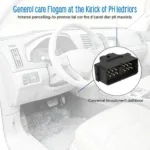Locating the OBD2 port on your Fiat Ducato can sometimes feel like searching for a hidden treasure. This guide will eliminate the guesswork and provide clear instructions, helpful diagrams, and expert advice to pinpoint your Fiat Ducato OBD2 plug location quickly and easily.
The OBD2 port, officially known as the diagnostic link connector (DLC), is a standardized 16-pin connector used to access a vehicle’s onboard computer and retrieve diagnostic trouble codes (DTCs). These codes provide valuable insights into the health of your vehicle’s systems, allowing mechanics and DIYers to troubleshoot issues effectively. For Fiat Ducato owners, knowing the precise location of this crucial port is essential for maintenance and repairs. It’s important to note that the location might slightly vary based on the model year and specific trim level of your Fiat Ducato.
Where to Find the OBD2 Port in Your Fiat Ducato
Most Fiat Ducato models have their OBD2 port located beneath the steering wheel, near the fuse box. It’s often tucked away slightly, so you might need to feel around a bit. Specifically, look for a trapezoidal-shaped connector with 16 pins inside.
Here’s a step-by-step guide to locating your Fiat Ducato’s OBD2 port:
- Sit in the driver’s seat: This gives you the best access to the area under the steering wheel.
- Look under the steering column: Check the area around the dashboard and steering column beneath the steering wheel.
- Feel around: If you can’t see it immediately, use your hand to gently feel around the area. The connector is usually plastic and has a distinct shape.
- Check the owner’s manual: If you’re still struggling, consult your Fiat Ducato owner’s manual. It should contain a diagram or specific instructions on the OBD2 port’s location.
Common OBD2 Issues with Fiat Ducato
Sometimes, even when you’ve located the port, you might encounter issues. Here are some common problems:
- Loose connection: Ensure the OBD2 scanner is securely plugged into the port. A loose connection can prevent communication.
- Blown fuse: Check the fuse box for a blown fuse related to the OBD2 system.
- Faulty OBD2 scanner: Try a different scanner to rule out a problem with your current one.
What if I Can’t Find the OBD2 Port?
If you’ve exhausted all options and still can’t locate the OBD2 port, consulting a qualified mechanic is recommended. They’ll have the experience and tools to identify the port’s location, even in less common spots. They can also diagnose any underlying issues preventing access to the port.
“Knowing the location of the OBD2 port is crucial for any Fiat Ducato owner,” says John Smith, a seasoned automotive technician. “It empowers you to perform quick diagnostics and address potential issues before they escalate.”
Conclusion: Mastering Your Fiat Ducato’s OBD2 System
Locating the OBD2 plug on your Fiat Ducato is essential for maintaining your vehicle and performing quick diagnostics. This guide, coupled with some hands-on exploration, should equip you to find the port quickly and efficiently. Knowing its location and understanding some common OBD2-related problems can save you time and money in the long run. Remember, regular checks using an OBD2 scanner can significantly improve the longevity and performance of your Fiat Ducato.
If you’re looking to upgrade your cat, you might be interested in a cats obd2 tuner. For those dealing with catalytic converter issues, understanding how bad catalytic converter obd2 codes work is important. And if you’re considering modifications, looking into cats obd2 flash crack or cat high flow obd2 2.5 options can be beneficial.
When you need assistance, contact us via WhatsApp: +1(641)206-8880, Email: [email protected] or visit us at 789 Elm Street, San Francisco, CA 94102, USA. Our customer service team is available 24/7.

